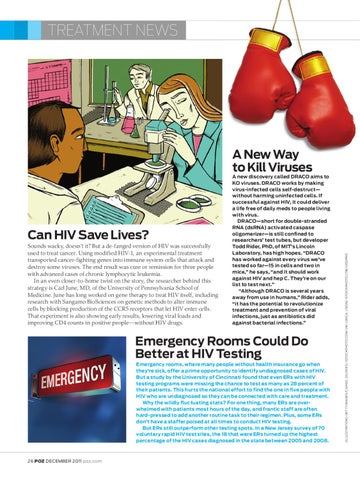TREATMENT NEWS
Can HIV Save Lives?
Sounds wacky, doesn’t it? But a de-fanged version of HIV was successfully used to treat cancer. Using modified HIV-1, an experimental treatment transported cancer-fighting genes into immune system cells that attack and destroy some viruses. The end result was cure or remission for three people with advanced cases of chronic lymphocytic leukemia. In an even closer-to-home twist on the story, the researcher behind this strategy is Carl June, MD, of the University of Pennsylvania School of Medicine. June has long worked on gene therapy to treat HIV itself, including research with Sangamo BioSciences on genetic methods to alter immune cells by blocking production of the CCR5 receptors that let HIV enter cells. That experiment is also showing early results, lowering viral loads and improving CD4 counts in positive people—without HIV drugs.
A new discovery called DRACO aims to KO viruses. DRACO works by making virus-infected cells self-destruct— without harming uninfected cells. If successful against HIV, it could deliver a life free of daily meds to people living with virus. DRACO—short for double-stranded RNA (dsRNA) activated caspase oligomerizer—is still confined to researchers’ test tubes, but developer Todd Rider, PhD, of MIT’s Lincoln Laboratory, has high hopes. “DRACO has worked against every virus we’ve tested so far—15 in cells and two in mice,” he says, “and it should work against HIV and hep C. They’re on our list to test next.” “Although DRACO is several years away from use in humans,” Rider adds, “it has the potential to revolutionize treatment and prevention of viral infections, just as antibiotics did against bacterial infections.”
Emergency Rooms Could Do Better at HIV Testing
Emergency rooms, where many people without health insurance go when they’re sick, offer a prime opportunity to identify undiagnosed cases of HIV. But a study by the University of Cincinnati found that even ERs with HIV testing programs were missing the chance to test as many as 28 percent of their patients. This hurts the national effort to find the one in five people with HIV who are undiagnosed so they can be connected with care and treatment. Why the wildly fluctuating stats? For one thing, many ERs are overwhelmed with patients most hours of the day, and frantic staff are often hard-pressed to add another routine task to their regimen. Plus, some ERs don’t have a staffer poised at all times to conduct HIV testing. But ERs still outperform other testing spots. In a New Jersey survey of 70 voluntary rapid HIV test sites, the 18 that were ERs turned up the highest percentage of the HIV cases diagnosed in the state between 2005 and 2008.
26 POZ DECEMBER 2011 poz.com
(ILLUSTRATION) GETTYIMAGES/CARGO; (GLOVES) ISTOCKPHOTO.COM/JIM JURICA; (SIGN) ISTOCKPHOTO.COM/DSGPRO
A New Way to Kill Viruses
